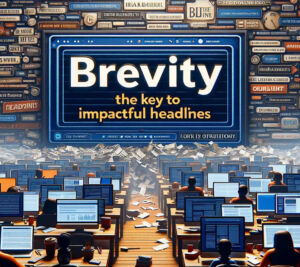The importance of headlines in content marketing cannot be overstated. A Reuters Institute for the Study of Journalism study reveals that about 20% of online news readers don’t venture beyond the headline or the first few lines.
This observation is echoed by Copyblogger’s Brian Clark, who suggests that while 80% of readers may scan the headline, only 20% will read further. This underscores the vital role headlines play in determining the fate of your content in a cluttered digital space.
To craft a headline that captivates and retains readers, viewers, or listeners, asking these eight critical questions before publishing can be transformative.
1. Does it Offer a Tangible Benefit?
Outstanding headlines address the reader’s needs or goals, highlighting the value and relevance of the content.
This approach taps into the reader’s desire for practical solutions and measurable outcomes. The inclusion of a specific number not only adds credibility but also sets a clear expectation of the content’s structure and depth.
It suggests a well-organized, actionable guide, making it more appealing for those seeking specific guidance.
Moreover, such a headline aligns perfectly with the user’s search intent, indicating that the article will provide direct, applicable advice to achieve a desired objective, in this case, better SEO performance.
This type of headline not only attracts readers but also establishes a sense of trust and expertise, encouraging deeper engagement with the content.
2. Is it Precisely Detailed?
Incorporating specific numbers or percentages can significantly enhance a title’s appeal. Numbers bring order, simplify complex content, and signal value, thereby engaging the reader more effectively.
They offer a sense of quantifiable insight or concrete takeaways, which is particularly attractive in an era of information overload.
For instance, a headline like “10 Proven Strategies to Increase Your Website Traffic” instantly communicates the article’s comprehensiveness and practicality.
This level of detail not only aids in setting clear expectations but also serves as a psychological hook.
People are naturally drawn to lists and organized information, finding it easier to process and remember. Moreover, precise details can also hint at the thoroughness of the research and the depth of knowledge presented in the content, thereby positioning it as a credible and authoritative source.
In essence, a well-crafted, detail-rich headline acts as a promise of value, making it a powerful tool in capturing and retaining reader interest.
3. Does it Target a Specific Audience?
Personalization in titles can be achieved by directly addressing the audience or highlighting their key characteristics, making the content more relevant and appealing.
This tactic creates a sense of exclusivity and a direct connection with the reader. For example, a headline like “Essential Time-Management Tips for Busy Parents” speaks directly to a specific group, immediately signaling to that demographic that the content is tailored to their unique challenges and interests.
Rapport Marketing believes this content marketing method of targeting not only increases the likelihood of engagement from the intended audience but also fosters a sense of community and understanding.
It shows that the content is created with a deep understanding of the audience’s needs and preferences.
Furthermore, this approach can help in establishing a loyal readership, as readers are more likely to return to a source that consistently addresses their specific situations and offers solutions that resonate with their personal or professional lives.
4. Does it Spark Curiosity?
Headlines that surprise or create vivid imagery can be particularly engaging. Using metaphors, contradictions, or unexpected expressions can pique interest and make your headline memorable.
Such headlines tap into the innate human curiosity, compelling readers to delve into the content to satisfy their intrigue.
For instance, a headline like “How a Simple Habit Changed My Life Unexpectedly” leverages the element of surprise and the promise of a compelling story, making it irresistible to the curious mind.
These types of headlines often pose implicit questions or present paradoxical statements that challenge conventional thinking, enticing readers to explore the content for answers or explanations.
Moreover, they can also set the tone for the article, hinting at a narrative that is as intriguing as the headline itself.
By engaging the reader’s imagination and curiosity right from the outset, these headlines can significantly increase the likelihood of the content being read and shared, amplifying its impact and reach.
5. Is it in the Audience’s Language?
The most effective headlines often resemble a casual conversation. Choosing active and incentivizing verbs makes your headlines more compelling and relatable.
By employing colloquialisms, slang, or industry-specific jargon, depending on the audience, a headline can immediately resonate with its intended readers.
This strategy is particularly effective as it breaks down formal barriers, making the content feel more accessible and engaging.
A headline that speaks the audience’s language is not just about words; it’s about connecting on a deeper level, demonstrating empathy and understanding of their worldviews and experiences.
This level of connection is crucial in establishing a lasting relationship with the reader, transforming them from a casual browser into a loyal follower.
 6. Is it Concise?
6. Is it Concise?
Brevity is key in headlines. Short, clear messages are processed more efficiently by the brain and are more likely to attract attention, especially in search engine results.
This conciseness is not just about word count; it’s about distilling the essence of the content into a few impactful words.
A concise headline strips away any superfluous language, focusing instead on the core message or value proposition. This clarity is crucial in a digital landscape where users often skim content.
A headline that gets straight to the point respects the reader’s time and attention span, making it more appealing and effective.
Furthermore, shorter headlines fit better on mobile screens and are more shareable on social media platforms, increasing their reach and effectiveness.
In essence, a concise headline acts as a powerful beacon amidst the sea of information, guiding readers quickly and effectively to the content that matters to them.
7. Does it Include a Subhead?
Pairing a concise headline with a more detailed subhead can provide additional context without overwhelming the reader. This technique is frequently used in non-fiction writing and is equally effective in digital content.
A well-crafted subhead complements the headline by elaborating on the topic or offering a sneak peek into the article’s key points or tone.
It serves as a bridge between the headline’s brevity and the article’s depth, balancing curiosity with information. This additional layer of detail helps in setting the right expectations and further engages the reader.
For instance, a headline might capture attention with a bold claim or question, while the subhead provides a summary or a teaser that encourages further reading.
The subhead also offers an opportunity to incorporate secondary keywords, enhancing SEO without compromising the headline’s clarity and impact.
In this way, the subhead not only enriches the reader’s understanding but also contributes to the overall visibility and effectiveness of the content.
 8. Is it SEO Optimized?
8. Is it SEO Optimized?
For online visibility, it’s crucial to create headlines that appeal to both search engines and readers.
Keep your headline under 60 characters, include a target keyword, and ensure it aligns with the content.
This ensures a strong content marketing strategy along with your SEO efforts.
Avoid over-optimizing for algorithms; focus instead on crafting a headline that will motivate readers to click. Additionally, incorporating SEO-friendly practices like using relevant and trending keywords can significantly boost your content’s discoverability.
An optimized headline also considers search intent, aligning with what users are actively seeking, thereby increasing the likelihood of engagement.
By thoughtfully integrating SEO principles with compelling, reader-focused language, your headline can effectively serve as a gateway, drawing in both search engine traffic and genuine reader interest, ultimately enhancing the reach and impact of your content.
In conclusion
Mastering headline writing is vital in the digital era, and crucial for capturing and keeping reader interest.
Essential strategies include: providing clear benefits, using specific details like numbers, targeting particular audiences, inciting curiosity, maintaining brevity, and focusing on SEO optimization.
These techniques create headlines that are engaging and memorable. Implementing these methods, as highlighted by Rapport Marketing, can significantly boost your content’s impact, ensuring it stands out in the competitive digital world.

